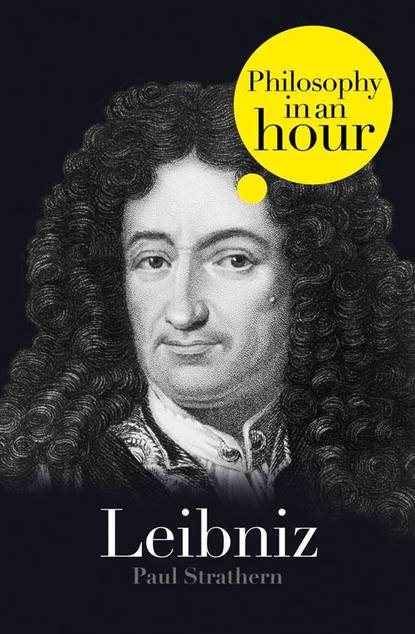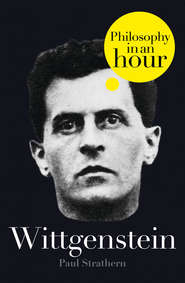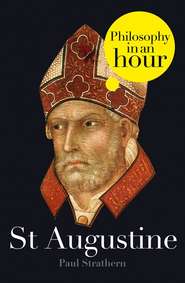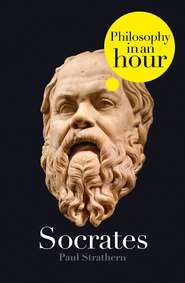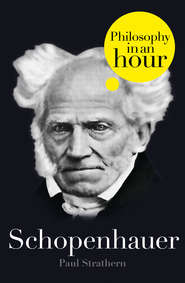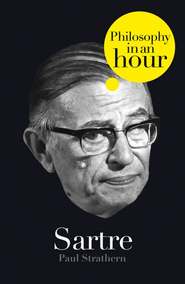По всем вопросам обращайтесь на: info@litportal.ru
(©) 2003-2024.
✖
Leibniz: Philosophy in an Hour
Настройки чтения
Размер шрифта
Высота строк
Поля
Paul Strathern
Leibniz was the first great German philosopher to produce an all-embracing philosophical system. He came to the remarkable conclusion that space and time do not exist – they are mere superstitious assumptions. Only things exist and only God is able to see things as they truly are – from a perspectiveless viewpoint. Yet the infinite of ultimate objects that make up the world (‘monads’) are not material: they are metaphysical and thus not subject to the laws of cause and effect. Their apparent interaction is the result of a ‘pre-established’ harmony that is part of God’s creation.Here is a concise, expert account of Leibniz’s life and philosophical ideas, entertainingly written and easy to understand. Also included are selections from Leibniz’s work, suggested further reading, and chronologies that place Leibniz in the context of the broader scheme of philosophy.
Leibniz
PHILOSOPHY IN AN HOUR
Paul Strathern
Contents
Cover (#u027f8f31-7f86-571c-9cf8-671eb1d00549)
Title Page (#u72d28b0c-5e45-5622-bb7b-b5af6d8b87fc)
Introduction (#u9bc7b47f-747e-5503-bf8f-ac2330451ad9)
Leibniz’s Life and Works (#uff70150b-fb64-54b4-921f-73479974b459)
Afterword (#litres_trial_promo)
Further Information (#litres_trial_promo)
From Leibniz’s Writings
Chronology of Significant Philosophical Dates (#litres_trial_promo)
Chronology of Leibniz’s Life (#litres_trial_promo)
Recommended Reading (#litres_trial_promo)
About the Author (#litres_trial_promo)
Copyright (#litres_trial_promo)
About the Publisher (#litres_trial_promo)
Introduction (#ubc530271-fed1-5288-802c-cc6aed85d420)
Leibniz was the archetypal caricature genius. He lived a life rich in incidents of high farce, of whose nature he was seldom aware. He knew everything about everything, yet he simply didn’t understand how ordinary people thought and behaved. This said, he was certainly one of the more presentable philosophers (though this probably says more about philosophers than about Leibniz). He appeared at courts throughout Europe, where the royals and aristocrats even took him seriously (though this probably says more about the royals and aristocrats …). For almost his entire adult life Leibniz was employed by the court at Hanover – and several other courts at the same time. He always took on as many appointments as he could and insisted upon being paid the full salary for these positions. He would become highly indignant when his pay was stopped because his employers had heard he was off working somewhere else.
To list Leibniz’s achievements would once again make him sound like a parodic exaggeration of genius. In fact it’s impossible to list all his ideas and discoveries, many of which he kept in a trunkload of papers that have yet to be published in their entirety. Fortunately Leibniz is of interest to us mainly as a philosopher. Yet even here the picture remains unclear. Bertrand Russell, who wrote one of the finest critical works on Leibniz’s philosophy, was of the opinion that Leibniz had produced two philosophies. The first was a simple philosophy for public consumption: a shallow optimistic metaphysics intended to delight princesses. His other, less optimistic ideas he consigned to his trunk. These were part of a more complex, logical, and profound system which could only be understood with difficulty by minds of the caliber of Leibniz himself (and Russell, of course). Characteristically, both of these philosophies remained unfinished – if indeed they really are two separate philosophies. Most other commentators, not having minds equal to Leibniz or Russell, claim that the simple philosophy and the complex one are really part and parcel of the same thing – which is neither as simple nor as complex as its two parts. Having cleared up these basic points, we may now proceed to Leibniz’s life.
Leibniz’s Life and Works (#ulink_6b1bb12c-0c2c-54a7-9fd8-b789b0e34300)
His life began, seriously enough, on July 1, 1646, in Leipzig. Three years later came the end of the Thirty Years War, which had swept through Europe and left Germany in a state of devastation. This catastrophe was to cast its shadows over the European political scene for decades to come, in much the same way that the shades of World War II have only recently begun to fade in Eastern Europe.
Leibniz’s father, Friedrich Leibnütz, was professor of moral philosophy at Leipzig University. His mother, Catherina, nee Schmuck, was Friedrich’s third wife. Their son was christened Gottfried Wilhelm Leibnütz (he was to change the spelling of his family name at the age of twenty). When Leibniz was just five years old his father died, leaving him and a sister to be brought up by their mother. According to all reports Catherina was a great believer in peace and harmony, who never spoke ill of anyone. Normally one would look upon this as a bit of the usual mythology. But in this case it must have been true. Leibniz was deeply affected by his mother and retained these very characteristics of hers to the end of his days. Despite everything (and this everything was to be quite something), Leibniz’s life was deeply harmonious. His long-term secretary Eckhart records that he never heard him speak ill of anyone. Leibniz’s philosophy too is permeated with a deep sense of harmony, and his lifelong political endeavours were invariably motivated by an attempt to bring harmony to the European scene.
Leibniz did go to school but said that most of his education was conducted at home, reading through his father’s library. He always claimed that he was self-taught, and it shows, even at this supreme level of genius. As a boy he read obsessively, following his train of thought as the fancy took him – until the entire floor of the library and all the tables and chairs were covered with opened books. The boy is all too recognizable in the man. In adult life Leibniz was capable of hatching half a dozen brilliant crackpot schemes in a week. These could range from a submarine to an entirely new form of clock, from a revolutionary lantern to a coach as fast as a modern car (when the roads were still only rutted tracks), from a horizontal windmill to a machine for measuring good and evil – none of which would ever be finished. Eat your heart out, Leonardo.
By the age of fourteen Leibniz was ready to take on the University of Leipzig. Here he studied law, quickly expanding his studies to include all possible interpretations of this subject, including the laws of physics, the laws of philosophy, the laws of mathematics, and almost the entire political concept and history of law. It was during this period that Leibniz first came across the writings of such celebrated lawyers as Galileo, Descartes, and Hobbes, who were revolutionizing scientific, philosophical, and political thought. Characteristically, Leibniz soon conceived the idea of harmonizing all this radical thought with the Scholasticism that it was in the process of replacing. In his spare time Leibniz became an avid student of alchemy (with the aim of reconciling it to chemistry), and he also wrote a paper that set out the theoretical basis for a computer (almost three hundred years before Turing’s seminal work on this subject).
By the time Leibniz had finished all this he was almost twenty, but when he applied for a degree the university told him he was too young. Having been found deficient in the one numerical system he was unable to master, Leibniz left Leipzig never to return. Instead he went to Altdorf, the university town of the free city of Nuremberg, where they immediately awarded him a doctor’s degree and offered him a professorship. The latter he declined, saying that he had ‘very different things in mind’.
Leibniz was ambitious and wanted to become a power to be reckoned with in the world. Fortunately for the world, he never achieved this – at least not in the manner he hoped. (Yet what did he hope for? What, under the circumstances of the age, could he have hoped for? A leading political post? Are we to picture one of the greatest minds of all time working as chief advisory minister to a German princedom the size of Rhode Island? Goethe may have occupied a similar position a century later at Weimar, but this was all grist to the mill for literature. Leibniz would certainly have taken a more active role. We can only imagine what the new drainage scheme, the express carriages, the revolutionary windmills, the Harmonious Guild of Alchemists, and law courts presided over by calculating machines would have looked like with Leibniz in charge. To say nothing of the effect on the citizens’ sanity.)
Doubtless with all this in mind, Leibniz now began putting himself about socially amongst the upper echelons of society. Eventually he was given a minor post at the court of the Prince elector, the Archbishop of Mainz, Johann Philip von Schönborn. The titles of German princes in those days were usually in inverse proportion to the size of the territory they ruled and their general importance. Johnny Beautifulborn’s comparatively modest string of titles indicated a man with some clout on the German political scene.
At this time the map of German-speaking Europe looked like a Ming vase dropped from a great height and reassembled by a surrealist. This piece of rococo fantasy was called, with equally surrealist panache, the Holy Roman Empire (its name failed on all three counts). Most of the separate princedoms, palatinates, electorates, and whathaveyous which made up this unempire lived in a fairly easygoing, quasi-independent state, and the whole place was probably as oddly pleasant to live in as it looked on the map. Things were just beginning to pick up after the Thirty Years’ War, and most people were only too pleased to live in a state of obscure provincialism ruled over by some harmless twit with an enormous name.
Unfortunately things were different across the Rhine in France – where instead of having nearly two hundred rulers and only one cheese worthy of the name, they now had just one ruler and a gastronomy fit for the Sun King at Versailles. Louis XIV was feeling in an expansive mood; France was Catholic, and many of the tiny German states across the Rhine were Protestant (or Catholic, it didn’t really matter). The Archbishop of Mainz realised that somehow Louis had to be diverted from expanding into Germany. He discussed this matter with the bright young adviser who had just joined his staff, and in no time Leibniz proposed an ingenious scheme. Why didn’t the archbishop try to interest Louis in a crusade, in mounting a great expedition to conquer Egypt? And if other countries could be persuaded to join in this holy war against the unbelievers, it might even pave the way to a harmonious reunion of the Catholic and Protestant churches.
The archbishop was overcome by this daring scheme, and Leibniz was at once dispatched to Paris to present it to Louis. But here Leibniz found himself encountering a few difficulties. It wasn’t easy to gain an audience with the Sun King at Versailles. You had to persuade his ministers that you were on an important mission, and Louis’s ministers didn’t seem to appreciate the seriousness of Leibniz’s plan. This included a wealth of compelling detail, including route maps, the size of army required, and diagrams of which cities to attack first. All these had been drawn up by a master German strategist whose purely theoretical military expertise and wide reading on the subject far outweighed that of any mere general. But Louis’s ministers would insist on pointing out that France hadn’t undertaken a crusade since the days of St. Louis, more than four centuries earlier.
Leibniz was to spend the next four years in Paris, though his enthusiasm for promoting his Egyptian project soon dwindled. He had far more important things to do (at the archbishop’s expense). In those days Paris was recognised throughout Europe as the world’s leading cultural and intellectual center, a situation which remains unchanged to this day in the eyes of its inhabitants. Leibniz quickly began circulating through the salons and attempting to meet as many leading intellectuals as he could. His temperament may have been that of a mad professor, but at this age he was still fairly good at disguising the fact. Fitted out in his best court finery, he cut quite an elegant figure, and under such circumstances his overpowering mental brilliance could easily be mistaken for sheer youthful vitality. The Duchess of Orleans, who appears to have regarded intellectuals much as we do now, was particularly impressed by this young German egghead: ‘It is so rare [for an intellectual] to be smartly dressed, and not to smell, and to understand jokes’. The duchess, who on the side was a bit of an intellectual herself, soon befriended Leibniz – one of the earliest of a whole string of well-connected duchesses and princesses with whom Leibniz kept in contact for the rest of his life.
Despite all this socializing, Leibniz remained as mentally hyperactive as ever. A cornucopia of brilliant ideas flowed from his brain, several of such fundamental importance that any one of them would have guaranteed its originator immortality in his field. It was during this period that he invented integral and differential calculus. He also discovered binary arithmetic, though he assumed (wrongly) that the Chinese had discovered this before him – as he understood (correctly) that it was implicit in the Yin and Yang theories of the I Ching. (Such a perception is typical of Leibniz’s sheer range.) Where the more familiar decimal system uses ten digits (0–9), binary arithmetic uses only two (0 and 1). This may appear long-winded, e.g., 1=1, 2=10, 3=11, 4=100, on to 9=1,001, 18=010010, and so forth. But Leibniz discovered that when certain categories of binary numbers (such as triples, for instance) are listed one below another, the 0s and 1s in the vertical columns often repeated in regular periods. This prompted him to hope that he might discover some entirely new general rules of mathematics – though he never realised this aim. He did realise, however, that binary is ideal for a mechanical system, which can work on simple stop-go or full-empty operations. With hindsight we can see that this is particularly the case for a system driven by electricity, with positive and negative. This has led to binary arithmetic being used in computers. Leibniz attempted to exploit the mechanical advantage of binary, and even sketched a calculating machine which incorporated his new mathematics. Yet he soon realised that such a machine was beyond available technology.
At this time the new philosophy of Descartes (Cartesianism) was the structuralism of the day amongst the Parisian chattering classes. But unlike structuralism (which treats a text as a structure, devoid of an author) it could also be taken seriously. Descartes’s philosophy represented a radical break with the Scholasticism of the medieval era. Instead of appealing to authority (that is, the largely Aristotelian teachings of the past), it was based upon reason and scientific method. Knowledge was built up, step by reasonable step, starting from indubitable certainty. The resemblance to mathematics was not coincidental. Descartes also excelled in this field. It was he who proposed the notion of coordinate geometry (whose Cartesian coordinates are named after him). By means of three axes (coordinates) standing at right angles to one another in three dimensions, the position of any point in space could be plotted with coordinate values.
Not surprisingly, this combination of mathematics, reason, and scientific method led Descartes to adopt a mechanistic view of the world. The universe was like a huge machine or clock mechanism which had initially been set in motion by God. Likewise, objects existed in absolute space: there was an absolute difference between their positions, and they were either absolutely at rest, or in motion.
Leibniz ingeniously perceived a flaw in this argument. According to this absolutist view, space must be different from the objects that are at rest, or in motion, within it. In which case space must be completely uniform throughout, like an absolute emptiness. But if so, how can we use it to measure location by means of coordinates? Such coordinates must inevitably be imaginary – they couldn’t actually exist in this featureless uniformity. But if such coordinates are imaginary, they must be arbitrarily imposed on space by us. So how can we possibly know that they are stationary? What would they be stationary in reference to?
Here we can see in embryo the argument for Einstein’s relativity. But instead of investigating this in mathematical terms (like Einstein), Leibniz chose to see it in terms of metaphysics. Here lay the germ of Leibniz’s mature philosophy.
In light of his preceding argument, Leibniz came to the remarkable conclusion that space did not exist. (He used a similar argument concerning time, coming to the same conclusion.) Leibniz maintained that as there was no absolute frame of reference, our notions of space and time were mere superstitious assumptions. When examined in the light of his argument, only things existed. The idea that one thing was faster than another, appeared at a later time than another, or was closer to us than another, depended entirely upon our relativistic point of view. Another person, viewing from another perspective, would see things differently. There was no absolute space or time: they simply didn’t exist. Only God was able to see things as they really were – from an utterly perspectiveless viewpoint devoid of space and time. So far Leibniz’s philosophy has distinct echoes of Platonic idealism – where the particular world around us is seen as an illusion reflecting an ultimate reality of ideal forms. But the new Cartesianism had shown how it was possible to base philosophic truth upon reason rather than on an unseen transcendent reality of ideas. Although Leibniz didn’t entirely agree with Descartes, he felt there was no going back to such an unscientific idealistic approach as Plato’s. Instead of Descartes’s mechanistic view of the world, Leibniz proposed a dynamic picture involving kinetic energy. As a result of Leibniz’s discovery of calculus, whose calculations involved diminishing values receding to the infinitesimally small, he came to see that things ultimately consisted of infinitesimally small points which had neither space nor time as attributes. These he would eventually call ‘monads’.
Вы ознакомились с фрагментом книги.
Приобретайте полный текст книги у нашего партнера:
Приобретайте полный текст книги у нашего партнера:





